|
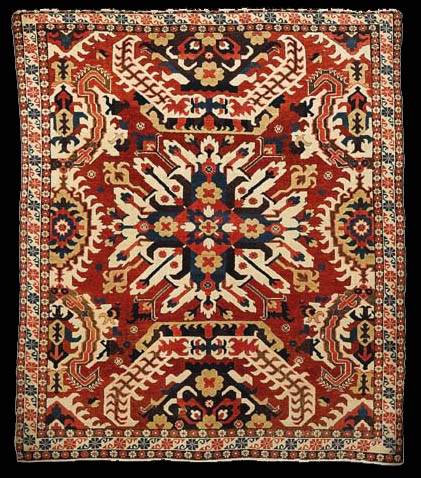
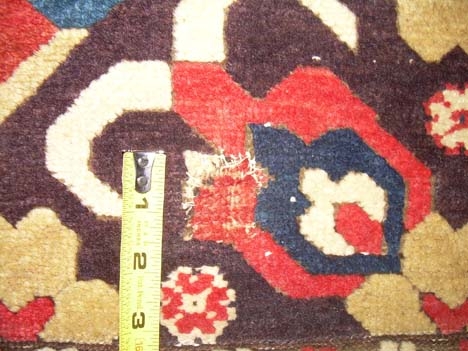
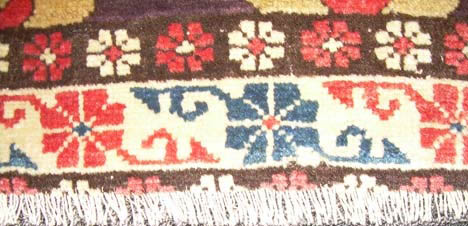
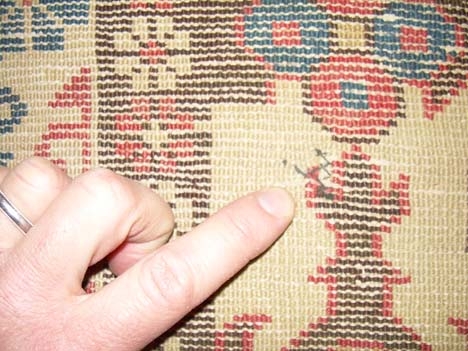
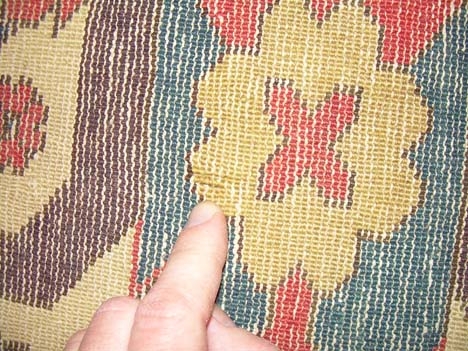 |
Early 19th century Sunburst rug, Azerbaijan.
Freeman's Sale No 1268 - Oriental Rugs & Carpets - Main & 3rd Floor Gallery
- Dec 14 2006 10:00
Lot 926
Chelaberd rug
South caucasus, early 19th century or earlier
6 ft. 1 in. x 5 ft. 4 in. Note: The present lot is an unusual single
medallion Chelaberd rug whose format and design elements relate directly to
various types of Chelaberds and other early Caucasian rugs. The single
central medallion design is related to the Caucasian 'Sunburst' rugs of the
late 18th and early 19th centuries, of which at least four examples are
known, three of which, like the present rug, have red grounds: the Victoria
and Albert Museum, London rug (inv. no. T.264-1927); Caucasian Sunburst Rug,
early 19th century, sold Sotheby's New York, Dec. 14, 1995, lot 58;
Caucasian Sunburst Rug, ca. 1800, sold Sotheby's London, May 29, 1998, lot
13; and Sunburst Kazak Rug, late 18th century, sold Christie's London, Oct.
18, 2001, lot 277 (Hali 85, Auction Price Guide, p.135, Mar.-Apr. 1996; Hali
120, Jan.-Feb. 2002, Auction Price Guide, p.128). These Caucasian 'Sunburst'
rugs have a single center medallion ending in palmette pendants centered by
angular hooked vines. While the present rug has a nearly identical single
central medallion, it's design differs from the 'Sunburst' rugs because at
each end of the medallion are three-sided ornamental medallions and angular
serrated leaves, and on each side of this central 'row' of medallions and
serrated leaves are two rows of palmettes – three complete palmettes and two
partial palmettes. Published examples of single medallion Chelaberds, often
referred to as 'Eagle Kazaks,' with three-sided ornamental medallions and
angular serrated leaves at each end, but without side rows of palmettes
include: Ulrich Schurmann, Caucasian Rugs, Maryland, 1990 (4th printing),
no. 29, p. 113 illus., and Christine Close, 'Kazak ad Aquile, Origine e
evoluzione decorativa,' in Ghereh, International Carpet & Textile Review,
no.14, Dec. 1997, fig. 1, p. 8 illus. Chelaberds with this design have been
also sold in a number of recent auctions, including: Sotheby's New York,
June 1, 2006, lot 43; Grogan & Co., Massachusetts, Sept. 26, 2005, lot 736;
Bonham's London, Oct. 12, 2004, lot 57; Sotheby's New York, Mar. 30, 2004,
lot 589; Sotheby's New York, Apr 1, 2003, lot 108; and Rippon Boswell & Co.,
Wiesbaden, Nov. 16, 2002, lot 65. The two side rows of palmettes have
stylistic antecedents in design elements of early Caucasian rugs including:
the late 17th century 'Palmette' carpet and the mid-18th century 'Dragon'
rug, Burrell collection, inv. numbers 9/65 and 9/70) (E. Gans-Ruedin,
Caucasian Carpets, New York, 1986, pp. 46-7, 50-1); the Dragon carpet,
Colonial Williamsburg Foundation, Virginia (Serare Yetkin, Early Caucasian
Carpets in Turkey, Vol. II, London, 1978, p.33); the 18th century
'Medallion' carpet, Thyssen-Bornemisza collection, Switzerland (E.
Gans-Ruedin, pp. 56-7) the 'Sunburst' carpets, Textile Museum, Washington,
D.C. (inv. no's. R 36.2.12; R 36.2.3) and in the Museum of Fine Arts, Boston
(inv. no. 06.2527) (Charles Grant Ellis, Early Caucasian Rugs, The Textile
Museum Fiftieth Anniversary, 1925-1975, Washington, D.C., 1975) and the
'Transitional' carpet, E. Cittone collection, Milan (Yetkin, p. 34).
PROVENANCE:
Estate of Robert Montgomery Scott, "Ardrossan," Radnor, Pennsylvania
Estimate $15,000-25,000
-Overall generally good condition, with most of rug having a medium clip,
the pile soft and somewhat lustrous, apart from missing rows of knots at one
end, a small patch in one of the three-sided ornamental medallions at one
end, oxidized browns and selvage losses/re-selvaging, and we believe, some
re-weaving in some of the oxidized brown areas. On back of rug in one corner
is an old JERREHIAN BROTHERS, PHILADELPHIA cloth label, sewn into the rug.
Inscribed in ink on the tag is 'PROPERTY OF MRS. EDGAR SCOTT/KAZAK 5' 3" x
6'3"'
-Knot count, horizontal; 8 knots, vertical 9 knots = 72 kpsi. warps are
partially depress; rug woven on a cotton foundation.
-Patch in three sided ornamental medallion measures approximately 1 1/8 x 1
1/2 in.
-Most of the field and the medallions, except for the patched area in the
one medallion and the browns which are oxidized in some spots down to the
foundation with warps/wefts visible, has generally full pike. We note there
are some white cotton knot heads that are visible, extending through the
piled surface.
At one end, the plain flatweave finished is generally complete but with some
minor losses, including some losses in a few spots with exposed warps, just
extending into piled outer border. At other outer end, most of end with
approx. 3/8 in. to 1/2 in. of the border is still remaining, with rest of
border gone.
-Single cord brown wool wrapped selvages do not appear original. There is a
missing selvage along each side with exposed cotton foundation. Due to
selvage loss extending into end of rug, 2 of the corners have losses and are
thus partial. The selvage loss is most prominent in one part of one selvage,
with an approx. 19 in. long area of missing selvage and exposed cotton
foundations.
-A small localized area of brown inner minor border is discolored with a
foreign surface substance; also a small localized stain in one of the
palmettes seen on reverse.
-Some areas of rug with some stitched repairs and small tears. These
include: An approx. 1 1/4 in. area is stitched with blue thread on reverse
in part of center medallion affecting tomato red and blue areas; in central
medallion, an approximate 5/8 long vertical tear in rug; an approx. 2 in.
long areas is stitched with blue thread on reverse in part of the 'eagle'
medallion. Some tears largest approx. 1 1/8 in. long in part of brown area
of one of the palmettes along side; and an approx. 3/4 in. area stitched
with blue thread in same palmette; an approx. 3/4 in. area stitched with
blue thread on reverse in one of palmettes along side; and minor tearing in
one of camel colored flowerheads just off center medallion.
-Rug is generally pliable, but has some dry areas as evidenced by the above
small years/stitched areas in the rug.
Sold for $300,000
Hali Magazine (16 January 2007):
"The most intriguing rug of the week was the striking Caucasian rug (14
December 2006, lot 926) in Philadelphia, one of several items in the sale
from the estate of Robert Montgomery Scott, whose patrician Pennsylvania
family were the inspiration for the 1930s Broadway play The Philadelphia
Story, subsequently made into an Oscar winning movie starring Katherine
Hepburn, James Stewart and Cary Grant.
With a cloth label on the back indicating that it had been purchased by
the Scott family from Jerrehian Brothers in Philadelphia, Freeman’s
catalogue suggested that the Caucasian was an interesting variant of the
small group of early 19th century single ‘sunburst’ medallion rugs, the
precursors to the so-called ‘Chelaberds’ or ‘Eagle Kazaks’ normally
attributed to the Karabagh region. However, the rows of palmettes and
‘chi’ motifs along each vertical axis of the field, which closely resemble
the designs in several 18th century so-called ‘transitional’ and ‘floral’
carpets (including a battered example offered at Christie’s New York in
the same week), suggest both an earlier dating and an alternative
provenance (see S. Yetkin, Early Caucasian Carpets in Turkey; M. H.
Beattie, Oriental Carpets in the Thyssen-Bornemisza Collection; E.
Gans-Ruedin, Caucasian Carpets).
Indeed, inspection of both its structure and palette confirmed that this
rug was a rare find. The four-ply cotton warps, two shoots of cotton
wefts, absence of warp depression, a thin pile and a fine weave, refute
the auctioneer’s attribution to the Karabagh region, and suggest instead
somewhere in the eastern Caucasus, while the palette, in particular a
beautiful pale aubergine, custard yellow and a pink red, resemble the
palette in some 18th century Kuba carpets. The modest borders, narrow
stripes decorated with blossoms, also resemble those found in later east
Caucasian rugs.
The phenomenal price achieved, $341,625, a record for any Caucasian rug at
auction including the famous Abadjian Star Kazak (SNY, January 1990),
reflect not only the apparently unique nature of this rug but also its
impressive beauty and remarkably good original condition. But the question
remains as to where it fits into our received wisdom. Arguably, it might
be one of a previously unrecorded transitional group between the Kuba
floral carpets and the single ‘sunburst’ medallion rugs. Rug designs often
transmute by first isolating an element from an earlier pattern before
forming the focal point of a new design. However, the greater likelihood
is that its field design was simply copied from an earlier piece, such as
the all-wool multiple medallion Caucasian carpet in the Thyssen-Bornemisza
Collection (Beattie, pl.XII), to which it bears a close stylistic
resemblance, and with which it shares many motif details.
During the second half of the 18th century, the Transcaucasus was in a
constant state of political flux, as various local khans vied with the
Ottomans, Persians and Russians for control of territory. It seems quite
plausible that an exquisite object such as this rug may have been made as
a gift. The ‘seccade’ or ‘dozar’ format, of which very few 18th century
Caucasian examples appear to have survived, supports the notion that this
rug was not made for the usual domestic consumption of the period, but
possibly for a special occasion or personage. More research would be
welcome, and it is hoped the anonymous telephone buyer will allow access
to the rug for further investigation." |





